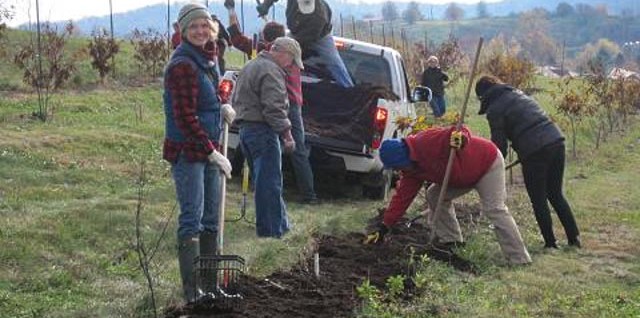 Several Virginia Chapter volunteers joined Smithsonian volunteers and staff of the Smithsonian Conservation Biology Institute (SCBI) near Front Royal on November 5th to prepare the mother tree orchard hosted by SCBI for winter. Thanks to the work of the orchard steward, Henry Ticknor, the orchard has been well cared for this season. The volunteer and staff crew of approximately 20 people were led by SCBI ecologist Dr. William McShea in renewing mulch around the trees to control weeds through the winter and the crew was able to complete the job before lunch, which was provided by SCBI.
Several Virginia Chapter volunteers joined Smithsonian volunteers and staff of the Smithsonian Conservation Biology Institute (SCBI) near Front Royal on November 5th to prepare the mother tree orchard hosted by SCBI for winter. Thanks to the work of the orchard steward, Henry Ticknor, the orchard has been well cared for this season. The volunteer and staff crew of approximately 20 people were led by SCBI ecologist Dr. William McShea in renewing mulch around the trees to control weeds through the winter and the crew was able to complete the job before lunch, which was provided by SCBI.
Volunteers also collected data on tree height and mortality. Some of the tallest trees were 2 meters tall. The uphill side of the orchard generally had less mortality and taller trees than the downhill rows. Information collected will be used to inform future plantings and possibly future selection of trees for use in the breeding program.
VA Chapter Board Chair Cathy Mayes worked closely with McShea to establish the orchard three years ago. The SCBI facility, which is affiliated with the National Zoo, houses rare and endangered animal species within carefully monitored enclosures. To avoid possible contact from the outside, the facility is also surrounded by an exclosure fence. The orchard is in the large area between the outer exclosure fence and the animal enclosure areas.
Mother tree orchards serve important functions in the effort to restore the American chestnut. By growing trees from the seed of large surviving American trees, the VA Chapter is preserving the some of the genetic diversity of the species, which is an essential aspect of species re-establishment. In addition, trees in a mother tree orchard may be used in the breeding program in the future. Because a mother tree orchard is accessible and contains many trees of similar size it reduces the travel and equipment that is often required for controlled pollination of trees in the wild.

